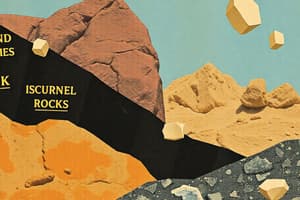Podcast
Questions and Answers
How are igneous rocks classified?
How are igneous rocks classified?
Igneous rocks are classified according to their origin, texture, and mineral composition.
How are igneous rocks formed?
How are igneous rocks formed?
Igneous rock is formed from magma or lava.
What are extrusive rocks?
What are extrusive rocks?
Extrusive rocks are igneous rocks formed from lava that erupted onto the Earth's surface.
What are intrusive rocks?
What are intrusive rocks?
What is basalt?
What is basalt?
What is granite?
What is granite?
What does the term 'origin' refer to in igneous rock classification?
What does the term 'origin' refer to in igneous rock classification?
What affects the texture of an igneous rock?
What affects the texture of an igneous rock?
What are the different textures of igneous rocks?
What are the different textures of igneous rocks?
What type of rock forms from rapid cooling lava?
What type of rock forms from rapid cooling lava?
What type of rock forms from slow cooling magma?
What type of rock forms from slow cooling magma?
What is true about intrusive rocks?
What is true about intrusive rocks?
What is true about extrusive rocks?
What is true about extrusive rocks?
What does a gelatin dessert with chopped fruit mixed in resemble?
What does a gelatin dessert with chopped fruit mixed in resemble?
What is porphyritic texture?
What is porphyritic texture?
When do porphyritic rocks form?
When do porphyritic rocks form?
Extrusive rocks have a fine-grained or glassy texture.
Extrusive rocks have a fine-grained or glassy texture.
How does the silica content of magma and lava affect its flow?
How does the silica content of magma and lava affect its flow?
What type of rocks usually forms from lava that is low in silica?
What type of rocks usually forms from lava that is low in silica?
What will magma that is high in silica usually form?
What will magma that is high in silica usually form?
What are many igneous rocks known for?
What are many igneous rocks known for?
What is notable about granite in construction?
What is notable about granite in construction?
What is basalt crushed for?
What is basalt crushed for?
What is pumice good for?
What is pumice good for?
What is perlite formed from?
What is perlite formed from?
Flashcards are hidden until you start studying
Study Notes
Classification
- Igneous rocks are classified based on their origin, texture, and mineral composition.
Formation
- Formed from magma (beneath Earth’s surface) or lava (on the surface).
Extrusive Rocks
- Formed from lava that has erupted onto the Earth's surface.
Intrusive Rocks
- Formed from magma that hardens beneath the Earth’s surface.
Basalt
- Most common extrusive rock, significantly constitutes the oceanic crust and features in shield volcanoes and lava plateaus.
Granite
- Most abundant intrusive rock in continental crust; coarser grained and often forms batholiths in mountain ranges.
Rock Origin
- Classified as either extrusive or intrusive; classification based on formation process.
Texture
- Depends on size and shape of mineral crystals; similar mineral compositions can yield different textures.
Texture Variations
- Different textures include fine-grained, coarse-grained, glassy, or porphyritic.
Cooling Processes
- Rapid cooling of lava results in fine-grained rocks with small crystals.
- Slow cooling of magma results in coarse-grained rocks with larger crystals.
Intrusive vs. Extrusive Crystals
- Intrusive rocks usually have larger crystals compared to extrusive rocks, which typically have smaller crystals.
Porphyritic Texture
- A texture resembling a gelatin dessert with fruit; characterized by large crystals scattered throughout a finer background.
Formation of Porphyritic Rocks
- Occurs in two stages: initial slow cooling forms large crystals, followed by rapid cooling leading to smaller crystals, often as magma rises toward the surface.
Extrusive Rock Texture
- Typically fine-grained or glassy; basalt's crystals are generally too small to be seen without a microscope.
Silica Content
- Affects the fluidity of magma or lava; lower silica typically leads to darker rocks like basalt, while higher silica results in lighter rocks like granite.
Durability
- Many igneous rocks are hard, dense, and durable, making them suitable for tools and construction materials throughout history.
Historical Use of Granite
- Used by ancient Egyptians for statues over 3,500 years ago, and by Incas in Peru for fortress construction; granite was popular for bridges and public buildings in the 1800s and early 1900s.
Use of Basalt
- Commonly crushed for gravel in construction.
Pumice
- Features a rough surface, making it effective as an abrasive for cleaning and polishing tasks.
Perlite
- Formed from heated obsidian; often mixed with soil for starting vegetable seeds.
Studying That Suits You
Use AI to generate personalized quizzes and flashcards to suit your learning preferences.




